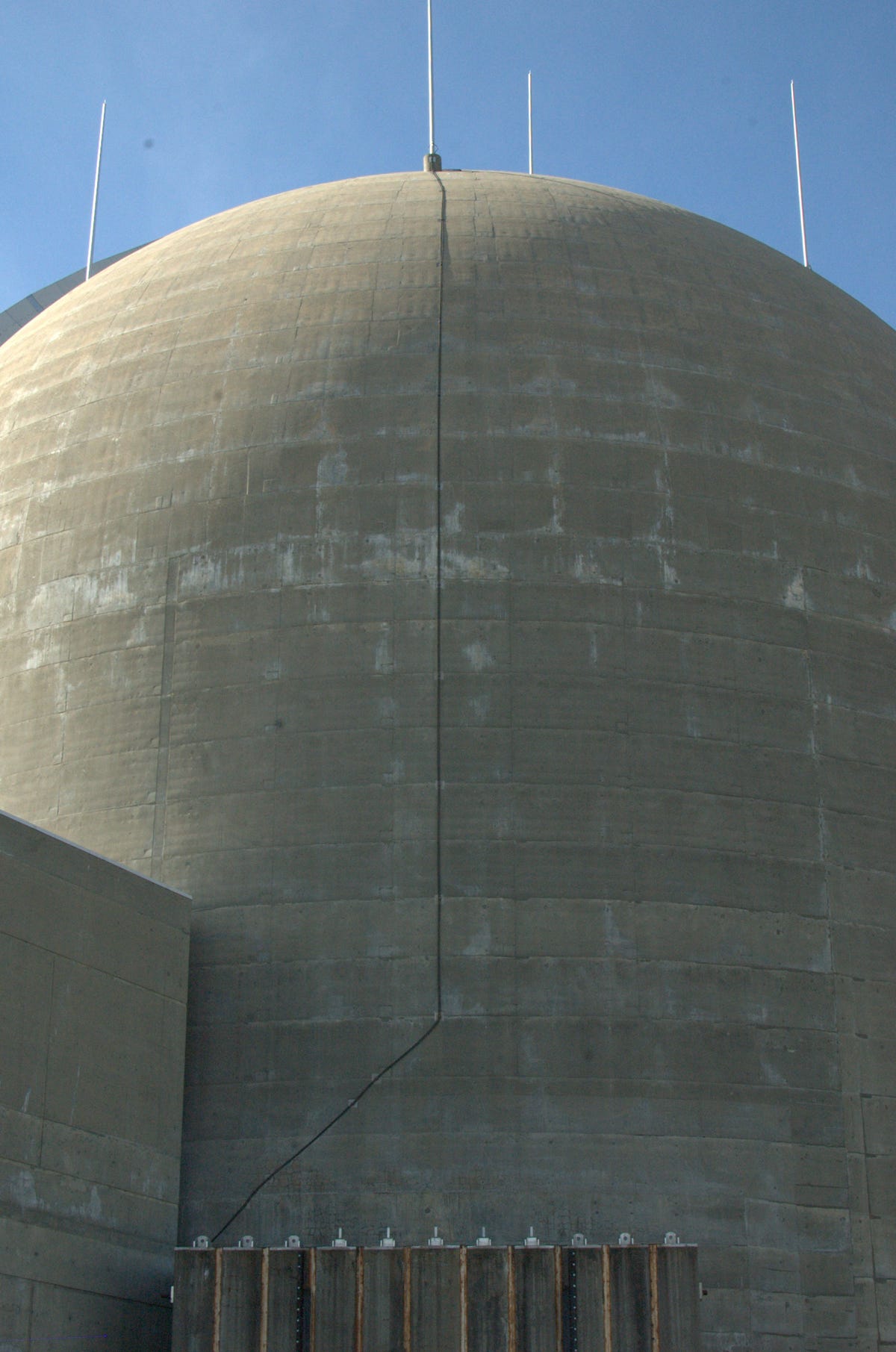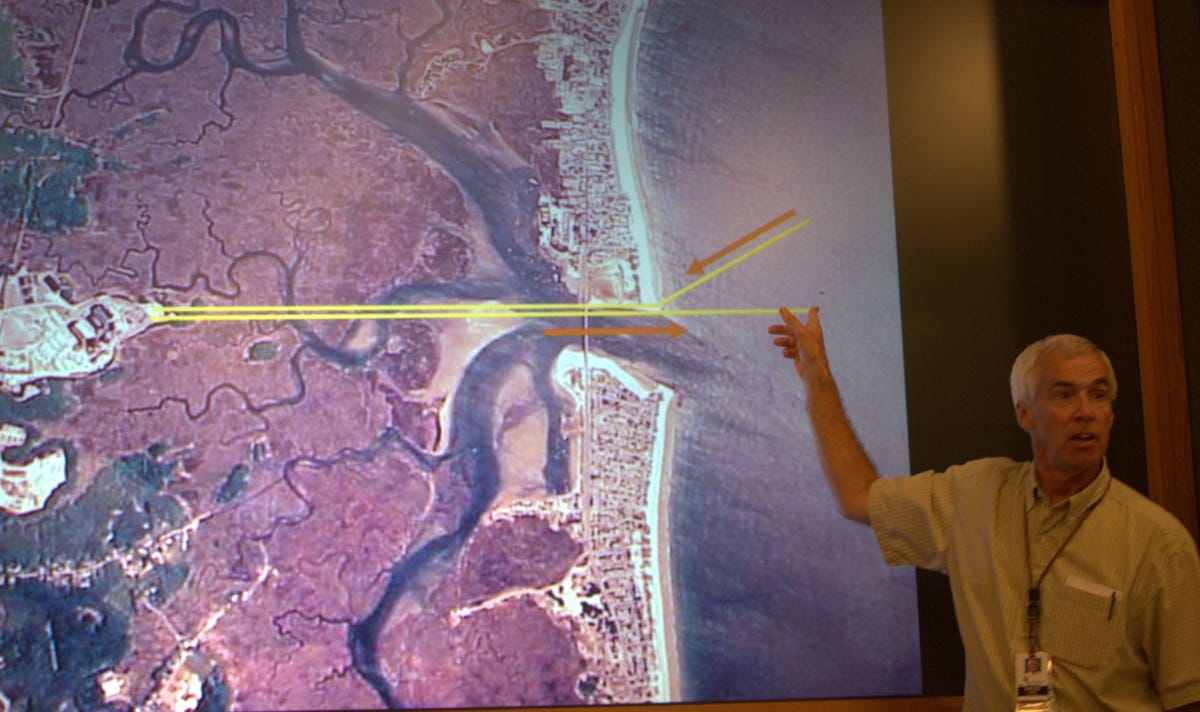Inside a nuclear power plant (photos)
CNET's Martin LaMonica reports on a tour of the Seabrook Station nuclear power plant, one of 104 such plants that supply 20 percent of the electricity in the U.S.

Dome over nuclear reactor
SEABROOK, N.H.--CNET reporter Martin LaMonica this week got a tour of Seabrook Station nuclear power plant in New Hampshire. Here is the dome covering the nuclear reactor.
The plant was first constructed in the late 1970s, but it didn't start operating until 1990 due to legal challenges and a change in ownership. The plant is now seeking to renew its original 40-year license for another 20 years. More than half of the nuclear plants in the United States have been given 20-year extensions to their licenses.
See related story: "Nukes 101: Up close and personal with nuclear power"
Fuel assembly
This is what a fuel assembly looks like, although a real one would be 12 feet tall. In each rod are fuel pellets made out of a compound of enriched uranium. There are 193 of these fuel assemblies held underwater in the Seabrook Station power plant, which generates more than 1,200 megawatts.
Control rods
Nuclear power plants are designed to provide heat, and thus power, at a steady rate, called "baseload" power in the industry. But the system needs to be slowed down sometimes or shut down for refueling. The control rods are the metal tubes that fit over fuel rods below them. They are made of an alloy that absorbs the neutrons being thrown off by the nuclear reaction in the reactor to slow the rate of fission. Plant operators can also release boron into the reactor water, which also slows the pace of fission.
Pellet model
This is how big a pellet for a fuel assembly is. A pellet this size holds as much energy as a ton of coal, according to the guide at the Seabrook Station power plant.
Turbine building
The main purpose of nearly all power plants is to make steam to drive a turbine seen in the half-domed assembly in white in the middle of this picture. In the case of a nuclear plant, it's the heat from the controlled splitting of atoms that is generating the heat. That heat is transferred to a separate water loop to turn it into steam, which is then sent through the spinning turbine to generate electricity.
Generator
At the Seabrook Station power plant, there are four turbines connected to each other (the first is a high-pressure turbine and the other three are low-pressure turbines). They are all connected to this generator on the left by a single spinning shaft. The heat from the operation made the room on our visit about 100 degrees and noisy.
Connecting to the grid
Here's where all the electricity goes. Nine tubes that have cables inside them (surrounded by an insulator gas) send electricity at 345,000 volts to the grid. They connect to three transmission lines at this interconnection point, two of which go to points in New Hampshire and one in Massachusetts.
There was once an incident about eight years ago where ice caked up on these transmission line connections, essentially causing a short that led to the computer turning the generator off. The plant itself needs a significant amount of power to operate, so it has diesel generators with enough fuel for a week.
Three water loops
Here's a schematic drawing of how the water loops within the power plant. The reactor heats water to about 550 degrees and is kept under high pressure, at 2,200 pounds per inch. That pressurized water is circulated to a heat exchanger, which creates steam from a second water loop. The steam is sent to the turbine to turn the generator and make electricity. That steam is cooled with ocean water and turned back into water and recirculated back through.
Long-term storage
The Seabrook Station was built with the capacity to store 20 years of spent fuel. But because the Nuclear Regulatory Commission is still working on long-term storage of nuclear waste, Seabrook Station, like other power plant operators, stores some of its spent fuel in dry casks. The concrete structures with the white doors hold canisters with the used fuel.
Storage pool
Seabrook Station was designed to store 20 years' worth of spent nuclear fuel on site. Every 18 months, spent fuel assemblies are rotated out and new ones put in. During this time, the plant is shut down for about three weeks. To remove the spent fuel assemblies, plant workers fill the tank above the reactor, take off the lid, pull out the spent assemblies, and put them here for storage. Water acts as a shield against the radioactive material in the assemblies. This is a photo of a presentation shown by a Seabrook Station employee.
Dropping fuel assemblies
A closer view of a fuel assembly being handled during refueling. The spent fuel assemblies are transferred underwater to a building adjacent to the reactor where they are kept in a pool underwater. Each assembly is 12 feet high. This is a photo of a presentation shown by a Seabrook Station employee.

Seawater cooling
One of the unique features of Seabrook Station is its water cooling system. There are giant pipes built underneath the sea marsh surrounding the plant that take water in from about eight feet above the ocean floor. After cooling the steam in the plant, the water is sent back out to sea. The full length of each tube is about three miles.
Basket catch
The Seabrook Station pulls in half a million gallons of seawater per minute and transports it three miles--from the ocean into its turbine building for cooling. But what about the fish? This is a serious concern because of the impact on the local ecosystem and fish populations. In normal conditions, the in-take pipes, which are about eight feet above the ocean floor, don't take in very much debris from the sea. You can see a few starfish and seaweed from the screens that take out debris. However, on stormy days, they need to continually empty out this basket and throw away the debris.
Pipe size
This pipe is not in use (there were two nuclear reactor units planned at Seabrook Station, though only one was built). But it gives you an idea of how big the pipes are that transfer the seawater into the turbine building for cooling. Above the three pipes that carry seawater are very large pumps with powerful motors.
Westinghouse design
Here's a model of the different pieces of the nuclear power plant, including the reactors on the left and the turbines and generator in blue. The dome over the reactor rises about 180 feet above ground level, but much of the reactor is below ground.
Nuclear fission
In case you were absent from physics class that day, here's a visual explanation of the concept behind atomic energy. A neutron is fired at an isotope of uranium, which causes it to split and throw off other neutrons. Each neutron hits another uranium nucleus, which then splits and throws off neutrons, causing a chain reaction. Each time an atom is split, it gives off a tremendous amount of energy in the form of heat. That heat is what creates steam to drive a turbine to make electricity in a generator.

